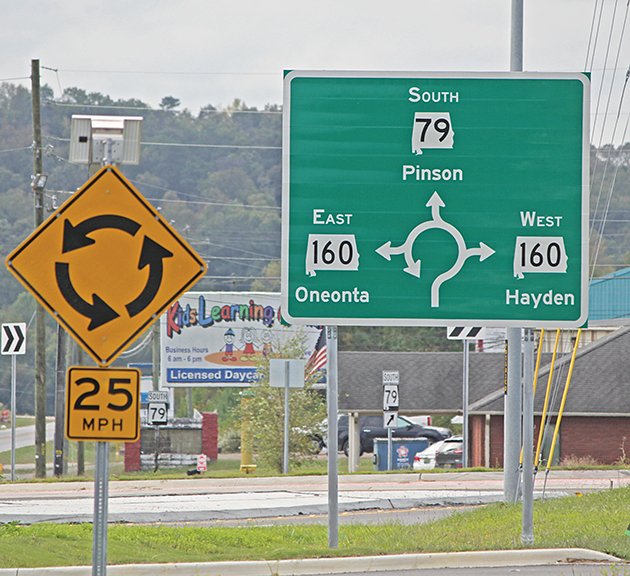The concept seems simple: Traffic goes counterclockwise around the roundabout, with approaching traffic yielding the right-of-way to vehicles already in the circle. Make a right turn onto the road you choose, and you’re done — no traffic lights, no broadside accidents, no right turns on red.
Still, the newly installed roundabout just a few miles from this writer’s home seems to be the source of great confusion. Cars pull into the roundabout without yielding, cutting off other traffic. A van already in the roundabout stops to let others in, while a pickup halts to contemplate which exit to take. An 18-wheeler pulling a dump trailer, the driver convinced that this should be a left turn, makes one into the circle and goes the wrong way, making another left to exit the roundabout.
Roundabouts aren’t common to drivers who spend most of their driving hours on interstate highways, but jurisdictions are making increased use of them on secondary roads. Advantages include elimination of left turns and preventing broadside accidents, causing traffic to slow to navigate the circle, and elimination of idling while waiting for traffic lights to change, saving time and reducing pollution.
Unfortunately, many drivers were never trained how to negotiate a roundabout, and some are confused when they encounter one. Any accidents that occur are likely to be minor, but no one wants a collision on their record — or the delays caused by a fender-bender.
Roundabouts are identified by yellow signs containing a circle of arrows pointing in a counterclockwise direction. It’s important to slow down and be prepared to stop before entering the circle (on a good day, you’ll be able to navigate the roundabout quickly, without stopping). It’s also important to figure out where you’ll exit the roundabout. Ideally, if you’re going straight, you’ll go halfway around the circle and take the second right. Some roundabouts, however, are offset from the exact center of the intersection, or may have more than four exits. Fortunately, if you miss yours, it’s a simple matter of going around the circle again.
Expect some roundabouts to be tighter than others. Designers may not have factored in 53-foot trailers, and it may be necessary to stay as far to the right as possible to allow room for trailer wheels. Another danger is the roundabout with multiple lanes. It may not be possible to keep a tractor trailer in one lane when going through the circle, and motorists may try to pass. Take the space you need, and watch out for others.
Many roundabouts have signs on the approach that indicate where each route exits the device. A look at the sign can give you a good idea where to turn.
Another sign that can cause consternation and, occasionally, an expensive collision, is the clearance sign that indicates the room beneath a bridge deck or other overhead obstruction. In a perfect world, every obstruction would be 14 feet high and clearly marked. As any driver can tell you however, it doesn’t work that way.
Before even reading the sign, every driver should know the height of the vehicle he or she is driving. Don’t assume it’s 13 feet, 6 inches. Most drivers assume that a standard tractor and trailer will get under a 13 foot, 6 inch obstruction and, most of the time, they’re right. Suspension work, new tires and other factors can raise a vehicle’s height imperceptibly, unknown to the driver until it’s too late. Some aerodynamic devices can also add a small amount of height.
Also consider the possibility that the sign could be inaccurate. It’s not uncommon for a city or county to add a layer of pavement to the road, reducing the available clearance by an inch or two, and if the sign isn’t changed, drivers can be misled. Packed snow, ice, sand or other substances can also raise the road surface, making what would a tight squeeze in fair weather into an accident waiting to happen at other times.
GPS mapping devices may or may not have accurate height information. Never assume that an obstruction on a GPS recommended route is high enough to clear without checking.
If either the road surface or the overhead obstruction isn’t perfectly horizontal, clearance can be restricted on one side or the other. A truck that will clear in the left lane may hit in the right lane or on the shoulder.
Know the height of your vehicle, look for and read clearance signs when approaching a bridge or obstruction and, if you aren’t sure, approach slowly with your four-way flashers engaged. It’s better to temporarily delay a few impatient drivers than to hit a bridge, possibly closing the road for hours.
If your strategy involves watching other trucks go underneath the obstruction, make sure the trucks that clear it are the same or higher clearance than your own vehicle. A tractor and tanker, for example, might only be 11 feet high. For example, to avoid constant rerouting, postal trailers in Chicago are often 12 feet, 6 inches, a foot shorter than a standard van trailer.
Finally, if contact is made with a bridge or other obstruction, check carefully for damage before proceeding. A hole in the top or sidewall of a van or refrigerated trailer can weaken its ability to carry weight. In a worst-case scenario, after a few miles of bumps and vibrations a small area of damage can become a collapsed trailer.
As too many drivers have learned, it’s always your responsibility to make sure your vehicle will clear overhead obstructions. Know before you go, and check when you get there.
Cliff Abbott is an experienced commercial vehicle driver and owner-operator who still holds a CDL in his home state of Alabama. In nearly 40 years in trucking, he’s been an instructor and trainer and has managed safety and recruiting operations for several carriers. Having never lost his love of the road, Cliff has written a book and hundreds of songs and has been writing for The Trucker for more than a decade.















I remember the first time I encountered one. My trainer was sleeping and the sign was had the same highway number on 3 of the arrows. I had no idea of which exit to use. I went around that circle about 4 times before he finally got up to see what was happening. I think we went around two more times before he got his bearings. We both laughed as we started down the highway again. What a dizzy experience. They put 6 or so round-abouts in my town. Some are good, some that were built were nothing but a tax waste in a round-about way!
Modern roundabouts are designed for trucks, large vehicles, and trailer towing vehicles by including the center flat area around the circle. It’s not a sidewalk, it’s called a truck apron, and it’s for trucks to begin a sharp right or end a left or U-turn on. But they should obey the warning speed and know their vehicle.
Roundabout Trucks Videos:
Million mile driver: https://www.youtube.com/watch?v=a4jV5MxCwGY&feature=youtu.be
U-turn, Washtenaw County: https://www.youtube.com/watch?v=Ub7QYTFesFY&feature=youtu.be
STAA, Porterville, CA: https://www.youtube.com/watch?v=3zPsUisOz_c&t=6s
FHWA: http://www.youtube.com/watch?v=0nVzsC2fOQw
Washington County, WI: http://tinyurl.com/trucksRABwi
U-turn: http://tinyurl.com/rabtruckuturn
Windsor-Essex Parkway, Canada: http://tinyurl.com/windsoressexRAB
Washington DOT simulation: https://www.youtube.com/watch?v=JI0L2AolOCQ
Washington DOT US2/Rice Rd: https://www.youtube.com/watch?v=P3k65uS5-EE
Oregon DOT tests: Deschutes County Fairgrounds https://tinyurl.com/y7yfpw5q
Portland Meadows Parking lot https://tinyurl.com/ycxpqf3u
Medford: https://www.youtube.com/watch?v=Kyenfyx_g0o
Opelika, AL: http://opelika-al.gov/CivicMedia?VID=3#player
Baker Road at Dan Hoey, Washtenaw County: https://www.youtube.com/watch?v=Re-uTDOoc3k&feature=youtu.be
Alaska DOT: http://dot.alaska.gov/nreg/danby-wembley/
Florida DOT: https://www.fdot.gov/agencyresources/roundabouts/index.shtm
Truck Apron how to: https://www.youtube.com/watch?v=jGM8UGfgeMg
Trucks in action, Green Bay: https://www.youtube.com/watch?v=Jz54OFvaTMw
Trucks Use Both Lanes, just like at other intersections:
Anderson, CA: https://goo.gl/maps/kXoMwuF67GHAQqZa8
The “writer” assumes the concept is simple. Just…. yada yada…… NO! The rules are potentially different at every roundabout and you must read the signs and try to dissect and digest the “instructions” before you get there. Oops! What was rule #3? Hang on, I gotta back up and read that again.
We are Americans — not Canadians or British. It is called a “traffic circle.”
Having a Roundabout I think in Clarksville Tn will be very good ,but the citizens also need to be educate on the roundabout as well.The reason that I say that is because some of our citizens have never had the opportunity to utilize a roundabout,and most of all their should be plenty of warning sign installed letting the citizens know about the roundabout.